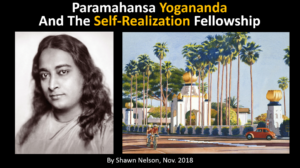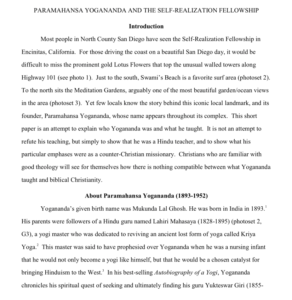Paramahansa Yogananda And The Self-Realization Fellowship
By Shawn Nelson
November 2018
Paramahansa Yogananda was the founder of the Self-Realization Fellowship (with a location in Encinitas, CA). This paper explains who he was and what he taught.
This paper was in partial fulfillment of the requirements for the course titled Advanced New Religious Movements (AP905) taken at Veritas International University in November, 2018.
Copyright © 2018 Shawn Nelson.
There is also a PowerPoint for this paper under the Download button.
Introduction
Most people in North County San Diego have seen the Self-Realization Fellowship in Encinitas, California. For those driving the coast on a beautiful San Diego day, it would be difficult to miss the prominent gold Lotus Flowers that top the unusual walled towers along Highway 101 (see photo 1). Just to the south, Swami’s Beach is a favorite surf area (photoset 2). To the north sits the Meditation Gardens, arguably one of the most beautiful garden/ocean views in the area (photoset 3). Yet few locals know the story behind this iconic local landmark, and its founder, Paramahansa Yogananda, whose name appears throughout its complex. This short paper is an attempt to explain who Yogananda was and what he taught. It is not an attempt to refute his teaching, but simply to show that he was a Hindu teacher, and to show what his particular emphases were as a counter-Christian missionary. Christians who are familiar with good theology will see for themselves how there is nothing compatible between what Yogananda taught and biblical Christianity.
About Paramahansa Yogananda (1893-1952)
Yogananda’s given birth name was Mukunda Lal Ghosh. He was born in India in 1893.[1] His parents were followers of a Hindu guru named Lahiri Mahasaya (1828-1895) (photoset 2, G3), a yogi master who was dedicated to reviving an ancient lost form of yoga called Kriya Yoga.[2] This master was said to have prophesied over Yogananda when he was a nursing infant that he would not only become a yogi like himself, but that he would be a chosen catalyst for bringing Hinduism to the West.[3] In his best-selling Autobiography of a Yogi, Yogananda chronicles his spiritual quest of seeking and ultimately finding his guru Yukteswar Giri (1855-1936) in India, and how he learned to master the Hindu religion under him to become a yogi guru himself. After being personally invited by the liberal Unitarian Church to come to America in 1920 to preach on the unity of all religions, he travelled extensively throughout the United States, teaching eager American crowds his yoga religion. He had an unusual ability to captivate audiences with his deep, melodic voice and unusual appearance. Although wildly popular wherever he travelled, he eventually began to concentrate more on the Los Angeles area where he felt people were more receptive to his message. Eventually, James Lynn (1892-1955), a wealthy oil and insurance tycoon became a convert and bankrolled the first Self-Realization Fellowship center in Los Angeles in 1925. Ten years later, Lynn purchased the thirty-five-acre beachfront property in Encinitas, built a hermitage and temple—all while Yogananda was away in India—and gave it to Yogananda as a surprise gift upon his return. By 1999, the Self-Realization Fellowship would have five-hundred similar meditation centers in fifty-five countries.[4] And it shows no signs of slowing down.
Unprecedented Success
Americans and Europeans were already warming up to Hinduism and Buddhism through popular writers like Ralph Waldo Emerson and Friedrich Nietzsche[5] by the time the first Hindu missionary arrived in 1893 to speak at the World’s Parliament of Religions in Chicago.[6] His name was Swami Vivekananda (1863-1902) but he had less success because he was only in the United States for a few years, and then he returned home. Yogananda, on the other hand, was the first Hindu missionary to remain in the United States. He is a kind of “Hudson Taylor”[7] for Hinduism, the first long-term pioneer of an Eastern counter-Christian missionary movement. To say that Yogananda has had a profound impact on modern American culture is an understatement. He has had a major impact on every generation since he first set foot on American soil nearly one-hundred years ago.
Consider his impact on Baby Boomers, my parent’s generation. George Harrison, lead guitarist of the Beatles in the 1960s, said when someone gave him a copy of Yogananda’s Autobiography in India, the photo on the cover grabbed him (photoset 5, B):
[I] just looked at the cover, and he just zapped me with his eyes… If I hadn’t read that, I probably wouldn’t have a life… I’d just be, you know, some horrible person with a pointless life. It just gave meaning to life… The Autobiography of a Yogi is the book that I keep stacks of around the house. And I give it out constantly, you know, to people. You know, like when people need regrooving. Read this.[8]
There is a photo of the most significant people who shaped modern culture on the cover of Sgt. Pepper’s Lonely Hearts Club Band (1967) by the Beatles (photoset 5, C). Yogananda and all three of his gurus (Mahavatar Babaji, Lahiri Mahasaya and Yukteswar Giri) are found mingling with the crowd alongside others like Marylyn Monroe, H. G. Wells, Albert Einstein and Sigmund Freud.
My generation, Generation X, is still fascinated with Yogananda. His Autobiography of a Yogi was named “100 Best Spiritual Books of the Century” in 1999 by HarperCollins. It was lauded as, “one of the most influential spiritual books of modern times.”[9] It is said that “Steve Jobs apparently had only one book on his iPad. Lo and behold, that book turns out to be the Autobiography of a Yogi” by Yogananda.[10] Knowing he was dying in 2011, Steve Jobs planned every detail of his own memorial. He gave a brown box to every attendee he invited. Inside the box was the Autobiography. Giddy attendees said Job’s last message was very clear: “Actualize yourself.”[11]
For Millennials and Generation Z, the words yoga and meditation are now common household words. These, along with other Eastern themes, are portrayed in Disney movies, practiced in public (and even some private Christian) schools, commercials show healthy people practicing them on beaches, and posters show people meditating and doing yoga in malls across America. These practices were once foreign to America in the 1920s but are now commonplace in this once “Christian” nation. And Yogananda was one of the first to introduce us to it.
Hinduism Dressed in Christian Clothes
Some say Yogananda produced a Hindu-Christian hybrid.[12] However, when one looks at what he taught, it is not proper to call it a hybrid because there is nothing of biblical Christianity left in his teachings. It is more appropriate to say that he repackaged Hinduism in an attempt to make it more appealing to Christians living under a Christian worldview. In missionary terminology this is called contextualization: what he really did was contextualize Hinduism. Here are the basic teachings of Hinduism along with statements from Yogananda showing that what he really embraced were Hindu beliefs.
Basic Overview of Hinduism
God. Hindus believe in pantheism. This is the belief that God is all and all is God. Yogananda taught that everything, including people, and even the matter of the universe (atoms), is divine.[13] He wrote, “Every grain of food you eat, every breath you take, is God.”[14] That is not to say that it is from God, but that it is God.
Creation. The universe is said to be an illusion in Hinduism (maya). One of Yogananda’s favorite illustrations was that the universe is like a movie. God (Spirit) individualized itself through “vibratory activity” to create this world much like the rays of light from a projector are individualized onto a movie screen.[15] Pure Spirit created a universe in which it divided itself “into many souls that they may play with Me.”[16] But just like a movie ultimately is not real, creation is also not real.
Man. Since everything is an illusion, man, too is an illusion. Man’s true essence is divine, and this is the gist of Yogananda’s “self-realization.” The goal is for people is to recognize that their true nature is divine and that they are actually one with God. The blooming Lotus Flowers around the Encinitas complex (photo 1) are illustrations of man realizing this divinity within.
Sin and evil. There is no sin in Hinduism. Instead, the big problem is everything in this world is an illusion. This illusion makes people ignorant of their true nature: divinity. Yogananda taught ignorance is “the root-cause of all human maladies.”[17] We are merely duped into thinking everything is real, including our pain (evil). However, “When we have finished seeing the motion picture, we know that nobody was killed; nobody was suffering.”[18] There is really then no evil, no disease, no disharmony, no separateness. Even Satan himself is an illusion (he is taught to be symbolic).[19] Hell does not exist.[20] Mankind’s Fall in the Garden in Genesis 3 is symbolic of falling into illusion, not falling into sin.[21]
Karma and reincarnation. The biggest problem in Hinduism is that illusion (maya) keeps people trapped in a near-endless cycle of rebirth. Man is travelling a path of upward evolution played out over many lives. Actions from previous lives affect subsequent ones. This is the law of karma. Yogananda said people work out karma through “many lifetimes of physical, mental, and spiritual evolution.”[22] Only then can we break the cycle of rebirth.
Jesus. Jesus was an ordinary man who attained “Christ Consciousness.” In other words, Jesus followed the path of “self-realization” and eventually arrived at the same knowledge Yogananda and others attained throughout history, thus achieving “Christ Consciousness.” However, Jesus was just one of many sent to help mankind throughout history (there were many others including Krishna, Buddha, Yogananda and his gurus).[23] Jesus did not die on the cross to provide salvation for our sins, but to be an example for us and show us the way to self-realization.
Salvation. Self-realization (not forgiveness) is what we need. Our big problem is ignorance of our divinity. We must follow the example of Jesus and become like Christ, resurrect the Christ within us, and attain “Christ Consciousness” for ourselves.[24] The “second coming” of Jesus will be when the masses finally achieve this.
Yoga: Paramahansa Yogananda’s Emphasis
Of course, Yogananda was a yogi who emphasized yoga. For him, yoga was a much quicker path to attaining self-realization than other Hindu approaches.
Kriya Yoga. Most Americans who practice yoga today are completely unaware that it is an ancient Hindu practice aimed at producing “union” with God (yoga means “union”).[25] Yogananda taught that it would normally take the average person a million years to climb the upward path of spiritual evolution to achieve self-realization.[26] However, using his yoga technique (which he named Kriya Yoga), it is taught that one can achieve this enlightenment in just three years’ time.[27] The key to Kriya Yoga, according to Yogananda, is that it is direct access to God. Other Hindu devotees seek reunification with God through personal deities (Brahma, Vishnu, Shiva, Krishna, etc.). But Yogananda taught it is far better (and faster) to have direct experience of God through yoga union. Here’s how he said it works.
Medulla oblongata. Per Yogananda, there is a point of contact between a person’s divine spirit and a person’s body. The medulla oblongata (which sits between the brain and the spinal cord) is where the contact occurs. Following Hindu teaching, he said that during creation, divine Spirit energy moved at different vibratory rates. This resulted in Spirit individualizing itself into conscious thought, and then it further condensed to create matter, including our own bodies.[28] The medulla is the doorway through which the divine Spirit provided and continues to provide the energy and lifeforce of matter. Using Kriya Yoga techniques, one learns to open this doorway not only to commune with the divine flow, but also to release vibratory Spirit power for healing of self and others.
Directly experiencing the divine. Yogananda taught that his yoga technique was a way for people to have direct experience with the divine. Through it, “God can be known, not as a theological concept but as an actual personal experience.”[29] By direct contact, a person can receive intuition knowledge of God directly, which is considered far better than mere “theoretical knowledge about” God. In yoga union, people are said to “experience direct perception of truth without the intermediary of the senses.”[30] The divine intuition that comes from meditation not only serves to make one aware of their divinity, but also acts as a type of soul guidance.
Chanting and affirmations. Since ultimately mind (conscious Spirit) drives matter, the mind has power to cure diseases.[31] One can concentrate the mind to consciously increase the supply of cosmic energy into a sick part of the body. It is said this can be done through positive affirmations made by the mind which reject the illusion of sickness. Some examples of affirmations from Yogananda are: “I am charming and magnetic, I am pleased with all; I wipe away all tears and fears. I have no enemy. I am the friend of all. I have no habits, In eating, thinking, behaving; I am free, I am free.”[32] Affirmations can be made for anything: material success, social success, sexual purity and curing bad habits.[33] Or, they can be made for healing things like eyes, stomach and teeth. These can be done verbally, with conscious chanting, done whispering or done in the mind only. There is even subconscious and “superconscious” chanting which is said to be the deepest and most powerful.[34]
Supporting Hinduism with the Bible?
Any Christian who is familiar with even basic Christian theology will know that the above is not consistent with Christianity. How then did Yogananda attempt to convince a largely Christian culture that the Bible supports Hinduism?
First, he said Jesus studied from gurus in India.
…the wise men of the East who made their way to the infant Jesus in Bethlehem were, in fact, great sages of India. Not only did the Indian masters come to Jesus, but he reciprocated their visit. During the unaccounted-for years of Jesus’ life—the Scripture remains silent about him from approximately age fourteen to thirty—he journeyed to India…[35]
He continued that it was during the “lost years” that we have no mention of in Scripture that Jesus studied and achieved “Christ Consciousness.” After preaching and teaching in India, Jesus returned to Israel to start his ministry there. Yogananda points to evidence of Jesus’ trip to India from supposed manuscripts found in a Tibetan monastery just over one-hundred years ago (this evidence has since been thoroughly refuted; see footnote).[36]
Next, he claimed Jesus imparted much deeper, secret teaching to his closest disciples. This teaching, he says, were “lost to institutional Christianity.”[37] He said the extra-biblical Gnostic gospels contain a better reflection of the real teachings of Jesus. Gnosticism was one of the biggest challenges to the early church. And it did, in fact, teach that man had a spark of the divine within. Through secret knowledge (gnosis) man must escape the physical world to arrive back to the divine. Yogananda appealed to these Gnostic writers by name (Basilides, Theodotus, Valentinus and Ptolemaeus) and to works like the Gospel of Thomas and the Nag Hammadi manuscripts (for a refutation of Gnosticism see footnote).[38]
Finally, he said that the Bible has a three-fold meaning. “All Scriptures, such as the Bhagavad Gita, or the Hindu Bible, and the Christian Bible, have a three-fold meaning.”[39] There is the material, the mental and the spiritual meanings, with the spiritual meaning being the deepest. He also said that all religions have teaching which is understood by the many (exoteric) and deeper teaching which is understood by the few or inner core (esoteric).[40] Clearly, the goal is to become one of the ardent few who understand the deeper meaning of the biblical text. This line of thinking is the only way he can attempt to harmonize religious texts that have competing worldviews (by ignoring the plain, ordinary meaning of the author of any text and inserting his own meaning instead).[41] Consider some examples of his eisegesis below.
Man shall live by the medulla oblongata. The familiar passage from Jesus’ Temptation says, “Man shall not live by bread alone, but by every word that comes from the mouth of God” (Mt. 4:4). Yogananda said the “mouth of God” refers to the medulla oblongata and the words that proceed from it “is life energy or cosmic vibratory force.”[42] What we really need for living is not food alone but the life energy that comes from our medulla oblongata.
Jesus said the light of the body is the “third eye.” Matthew 6:22: “The eye is the lamp of the body. So, if your eye is healthy, your whole body will be full of light.” Yogananda said this refers to a “third eye” that becomes visible during deep meditation, appearing in the middle of the forehead. This is a doorway into the presence of God.[43] If this “third eye” is healthy, then we are full of light.
The traditional Gospel message from John 3 is really about Hinduism. John 3:14-15: “And as Moses lifted up the serpent in the wilderness, so must the Son of Man be lifted up, that whoever believes in him may have eternal life.” He said the serpent refers to our consciousness and life force. When we lift our consciousness up through the “passageway at the base of the spine” (medulla oblongata) we will “gradually acquire the immutable state—Christ Consciousness, the Son of God.”[44]
Other passages, such as the Genesis account of creation is treated as pure allegory. Yogananda was taught by his guru that “Genesis is deeply symbolic, and cannot be grasped by a literal interpretation.”[45] His master went on to explain that the tree of life was actually the human body, the forbidden fruit was sex, the serpent is our desire for sex, and the knowledge of good and evil is illusion (maya).
Reasons for SRF Success
Yogananda had to do some severe scripture bending to get Hinduism to fit into the Christian Scriptures. Why then was he so successful in a “Christian” culture? Here are some likely reasons.
Charisma. It has already been mentioned that Yogananda had unusual charisma which many found appealing. When he arrived in America in 1920, most Americans had never seen a Hindu guru.[46] He was short, unusual in appearance, and did not dress like an American but as he did back home. “He looked strange, like a woman with long hair. But I remember his powerful eyes.”[47] His unusual appearance was matched by his unusual ability to spell-bind audiences. He was a very eloquent speaker with incredible charm. His voice was deep and melodic as he spoke to spellbound crowds about an unusual message (inner divinity).
Spectacular stories. His Autobiography is filled with many stories that seem to add credibility to his message.[48] It is filled with supposed miraculous healings, levitation, the sending of telepathic messages, mind-control, bodies and buildings that materialize and dematerialize, timeless shape-shifting gurus, people who no longer require food to survive, people resurrected from the dead, visions of the future, and encounters with Jesus himself.
Highly evangelistic. Yogananda was a missionary who wanted Hindu converts. This top priority is evident in his speaking and writing. He geared his books towards ordinary Americans. His wrote clearly and his books are easy-to-read. He attempted to support his beliefs with science. He was sure to include invitation for further study in every book and pamphlet. He included testimonies wherever possible. Here are some examples: “The Lessons have transformed my life as no other writings have.”[49] “I have been a student of the Self-Realization teachings just one year and my life has completely changed. My health has improved 100%.”[50] And “The year with SRF has brought me more peace and spiritual wisdom and answers to problems than time spent in any other practice.”[51]
Polemical. Yogananda was very much interested in attracting seekers. But he was not shy about speaking out against organized Christianity. He said the only thing the Christian church has produced is “unprofitable speculations” about God.[52] He called church dogma “theological debris.”[53] He said Jesus is so misunderstood today by modern Christians that he “is now being crucified by ignorant people.”[54] True Jesus-followers are those who meditate and aren’t the results of “intellectual theological seminaries.”[55] We must not be “satisfied with sermons, ceremonies, organizations, and festivities.”[56] What good is “church membership” and “outer ritual” while “never knowing him in reality by contacting him in meditation”? [57] Do we want to be “real Christ-ians” or “just members of Christian churchianity?”[58] Yoga is not “a theological concept” but “actual personal experience.”[59] Statements like these have strong appeal to those who are turned-off by organized religion and bad-church experiences.
Practical. As a master-Hindu-evangelist Yogananda targeted the practical needs of all people. He commonly said things like, “What human being has not longed to understand the meaning of existence, to fathom the ultimate purpose of creation?… We all want to experience lasting satisfaction and perfection, but is it really possible?”[60] He then presented yoga union as the way to inner fulfillment: “In truth, all the knowledge, creativity, love, joy, and peace we are looking for are right within us, the very essence of our beings.”[61] One pamphlet I found at the Meditation Garden (photoset 3, C) offers prospects “Step-by-step instruction…” on topics like “Friendship—the art of getting along with others; creating harmony in marriage and family life; finding your true vocation and balanced success and prosperity; … yoga methods of diet, healing, relaxation, and rejuvenation; living without stress and fear; … “life after death.”[62] It is no wonder why Yogananda drew followers from all walks of life: “prominent businessmen, judges, lawyers, even hardened journalists.”[63]
Conclusion
The purpose of this paper was not to refute Yogananda and the Self-Realization Fellowship teaching per se; it was simply to make people aware of what the Self-Realization Fellowship and its founder believes. Yogananda said he was revealing true Christianity to the West. But as was shown here, his Hindu message is not compatible at all with Christianity. Yogananda and his Self-Realization Fellowship have dramatically influenced our culture, moving us away from biblical Christianity by forcing a Hindu interpretation upon the biblical text.
Appendix 1: Photos of Self-Realization Fellowship, Encinitas
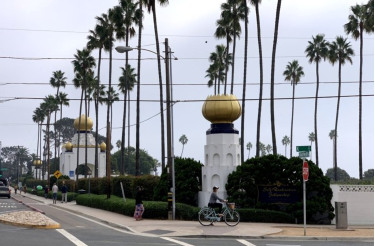
Photo 1: Golden Lotus Flowers top the towers along Highway 101, symbolic of a person’s journey into self-realization (“Christ consciousness”).
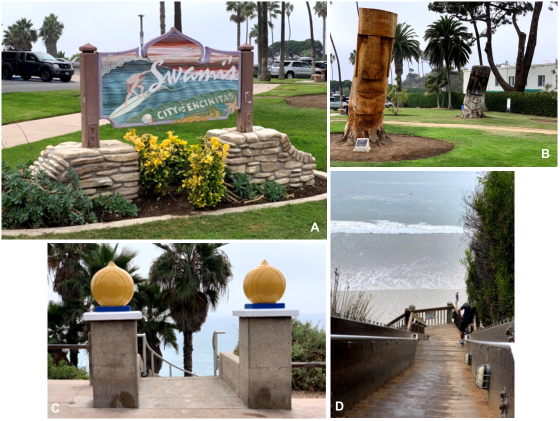
Photoset 2: Swami’s Beach (A), just to the south of the Self-Realization Fellowship in Encinitas. Buildings for retreat-goers and resident hermits can be seen beyond the Easter Island Heads (B). A walk through the Lotus Flower stairway (C) leads to the beach below, a favorite surf spot (D) in San Diego.

Photoset 3: The Meditation Garden (A) is arguably one of the nicest gardens in the area. It has ocean views (E), koi ponds (B), mini-waterfalls and a succulent garden (D). Notice the literature station (C) which has material for proselytizing visitors.

Photoset 4: The Self-Realization Fellowship Bookstore (A) reveals that what Yogananda brought to the United States was nothing other than Hinduism. In addition to clothing (H), various Hindu gods are available for purchase (B) including Krishna (D) ($4,900), Shiva (E) ($1,000), Buddha and Ganesh (F). The album (G) in the reading room (C) shows Jesus among many other enlightened ones. From left to right they show Babaji (G1), Jesus (G2), Lahiri Mahasaya (G3), Krishna (G4), Yukteswar Giri (G5) and finally Paramahansa Yogananda (G6).
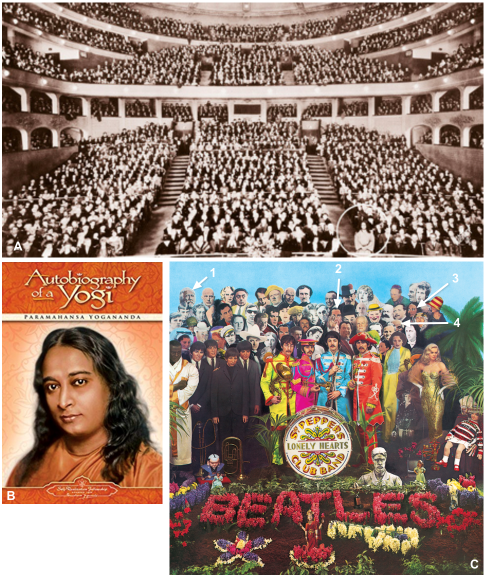
Photoset 5: Yogananda had an ability to draw and captivate large crowds. Yogananda’s first night teaching in Los Angeles (1925) drew 6,000 people (A), twice the capacity of the Philharmonic Auditorium. His best-selling Autobiography of A Yogi (B) was the only book Steve Jobs had on his iPad; he prearranged to give a copy to all he invited to his memorial. All four Self-Realization Fellowship gurus are found on the album cover for Sgt. Pepper’s Lonely Hearts Club Band by the Beatles: Yukteswar Giri (C1), Babaji (C2), Lahiri Mahasaya (C4) and Paramahansa Yoganda (C3) are present with other cultural icons like Marylyn Monroe and Albert Einstein.
Footnotes
- Paramahansa Yogananda, Autobiography of a Yogi (Los Angeles, CA: Self-Realization Fellowship, 2007), 4. ↑
- Ibid., 333, 334. ↑
- Ibid., 1. ↑
- John Weldon, “Self Realization Fellowship,” The John Ankerberg Show, accessed November 10, 2018, https://www.jashow.org/articles/self-realization-fellowship/. ↑
- Encyclopedia Britannica (Chicago, IL: Encyclopedia Britannica, 2016), s.v. “New Religious Movement.” ↑
- Elliot Miller, “Swami Yogananda and the Self-Realization Fellowship,” Christian Research Institute, accessed November 10, 2018, https://www.equip.org/article/swami-yogananda-and-the-self-realization-fellowship/. ↑
- Hudson Taylor (1832-1905) was a very successful Christian missionary pioneer in China. ↑
- Awake: The Life of Yogananda, directed by Paola di Florio and Lisa Leeman (CounterPoint Films, New York: Kino Lorber, 2014). ↑
- Yogananda, Autobiography of a Yogi, 1. ↑
- Awake: The Life of Yogananda. ↑
- Hitendra Wadhwa, “Steve Jobs’s Secret to Greatness: Yogananda,” Inc., June 21, 2015, https://www.inc.com/hitendra-wadhwa/steve-jobs-self-realization-yogananda.html. ↑
- Elliot Miller. ↑
- “God lives in every atom of creation.” See Paramahansa Yogananda, Scientific Healing Affirmations (Los Angeles, CA: Self-Realization Fellowship, 2011), Kindle location 882. ↑
- Ibid., Kindle location 2001. ↑
- Yogananda, Autobiography, chapter 30. ↑
- Paramahansa Yogananda, Journey to Self-Realization, New ed. (Los Angeles, CA: Self-Realization Fellowship, 1997), 32. ↑
- Paramahansa Yogananda, The Yoga of Jesus: Understanding the Hidden Teachings of the Gospels (Los Angeles: Self Realization Fellowship, 2007), Kindle locations 630, 631. ↑
- Yogananda, Journey to Self-Realization, 20. ↑
- Yogananda, The Yoga of Jesus, Kindle locations 327-329. ↑
- Ibid., Kindle locations 1228, 1229. ↑
- Yogananda, Scientific Healing Affirmations, Kindle locations 386-388. ↑
- Yogananda, The Yoga of Jesus, Kindle locations 929-938. ↑
- Ibid., Kindle locations 263-265. ↑
- Ibid., Kindle locations 324, 325. ↑
- Ibid., Kindle locations 141, 142. ↑
- Yogananda, Autobiography, 269. ↑
- Larry A. Nichols, George Mather, and Alvin J. Schmidt, Encyclopedic Dictionary of Cults, Sects, and World Religions (Grand Rapids, MI: Zondervan, 2006),415. ↑
- Self-Realization Fellowship, Worldwide Prayer Circle (Los Angeles, CA: Self-Realization Fellowship, 1984), 7. ↑
- Yogananda, The Yoga of Jesus, Kindle locations 628, 629. ↑
- Ibid., Kindle locations 2420, 2421. ↑
- Yogananda, Scientific Healing Affirmations, Kindle locations 215, 216. ↑
- Ibid., Kindle locations 718-723. ↑
- Ibid., Kindle locations 667-794. ↑
- Ibid., Kindle locations 464-466. ↑
- Yogananda, The Yoga of Jesus, Kindle locations 340-344. ↑
- For a refutation, see Douglas R. Groothuis, Jesus in an Age of Controversy (Eugene, OR: Wipf & Stock Pub, 2002), chapters 7 and 8. ↑
- Yogananda, The Yoga of Jesus, Kindle locations 100-102. ↑
- For a refutation see Groothuis, Jesus in an Age of Controversy, chapters 5 and 6. ↑
- Paramahansa Yogananda, The Second Coming of Christ (Los Angeles, CA: Self-Realization Fellowship, 2017), Kindle locations 146-148. ↑
- Yogananda, The Yoga of Jesus, Kindle location 911. ↑
- Eisegesis is reading one’s meaning into the text while exegesis is reading the author’s intended meaning from the text. Anytime somebody writes or speaks, they have a meaning which can be determined by the grammar of the words they used. Good Bible study and communication depends on trying to understand the author’s intended meaning from the text (exegesis), not forcing our own. Even Yogananda expected his readers to try to understand the meaning of his books by means of the grammar he used. ↑
- Yogananda, Scientific Healing Affirmations, Kindle locations 199-203. ↑
- Yogananda, The Yoga of Jesus, Kindle locations 1340-1344. ↑
- Ibid., Kindle locations 1181-1184. ↑
- Yogananda, Autobiography, 191. ↑
- As mentioned, there was one prior Hindu missionary before him. Swami Vivekananda visited briefly in 1893. But Paramahansa was the first missionary to stay permanently in the United States. ↑
- Ravi Shankar, famous sitar Indian musician, in Awake: The Life of Yogananda. ↑
- Space limitations prevent answering his miracles from a Christian perspective. In short, it is my belief that many of Yogananda’s “miracles” and visions were either psychologically induced, false or involve demonic forces at work. For more info about this see Norman Geisler, Signs and Wonders (Eugene, OR: Wipf and Stock Publishers, 1988), chapter 7. ↑
- Self-Realization Fellowship, Undreamed-Of Possibilities: An Introduction to Self-Realization Fellowship (Los Angeles, CA: Self-Realization Fellowship, 1982), 32. ↑
- Ibid. ↑
- Ibid. ↑
- Yogananda, Autobiography, 362. ↑
- Ibid. ↑
- Yogananda, The Second Coming of Christ, Kindle locations 120, 121. ↑
- Ibid., Kindle locations 307-309. ↑
- Ibid. ↑
- Yogananda, The Yoga of Jesus, Kindle locations 298, 299. ↑
- Ibid., Kindle locations 320-322. ↑
- Ibid., Kindle locations628, 629. ↑
- Self-Realization Fellowship, Undreamed-Of Possibilities, 3. ↑
- Ibid. ↑
- A card inserted into Ibid. ↑
- Awake: The Life of Yogananda. ↑
Bibliography
Awake: The Life of Yogananda. Directed by Paola di Florio and Lisa Leeman. CounterPoint Films. New York: Kino Lorber, 2014.
Encyclopedia Britannica. Chicago, IL: Encyclopedia Britannica, 2016.
Geisler, Norman. Signs and Wonders. Eugene, OR: Wipf and Stock Publishers, 1988.
Groothuis, Douglas R. Jesus in an Age of Controversy. Eugene, OR: Wipf & Stock Pub, 2002.
Miller, Elliot. “Swami Yogananda and the Self-Realization Fellowship.” Christian Research Institute. Accessed November 10, 2018. https://www.equip.org/article/swami-yogananda-and-the-self-realization-fellowship/.
Nichols, Larry A., George Mather, and Alvin J. Schmidt. Encyclopedic Dictionary of Cults, Sects, and World Religions. Grand Rapids, MI: Zondervan, 2006.
Self-Realization Fellowship. Worldwide Prayer Circle. Los Angeles, CA: Self-Realization Fellowship, 1984.
———. Undreamed-Of Possibilities: An Introduction to Self-Realization Fellowship. Los Angeles, CA: Self-Realization Fellowship, 1982.
Wadhwa, Hitendra. “Steve Jobs’s Secret to Greatness: Yogananda.” Inc. June 21, 2015. https://www.inc.com/hitendra-wadhwa/steve-jobs-self-realization-yogananda.html.
Weldon, John. “Self Realization Fellowship.” The John Ankerberg Show. Accessed November 10, 2018. https://www.jashow.org/articles/self-realization-fellowship/.
Yogananda, Paramahansa. Autobiography of a Yogi. Los Angeles, CA: Self-Realization Fellowship, 2007.
———. Journey to Self-Realization. New ed. Los Angeles, CA: Self-Realization Fellowship, 1997.
———. Scientific Healing Affirmations. Los Angeles, CA. Self-Realization Fellowship, 2011.
———. The Second Coming of Christ. Los Angeles, CA: Self-Realization Fellowship, 2017.
———. The Yoga of Jesus: Understanding the Hidden Teachings of the Gospels. Los Angeles: Self Realization Fellowship, 2007.

